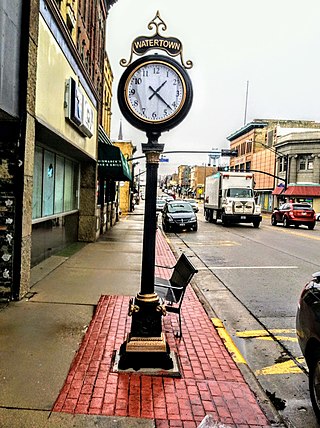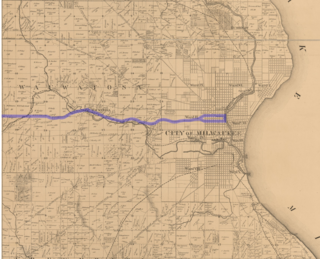Related Research Articles

Watertown is a city in Dodge and Jefferson counties in the U.S. state of Wisconsin. Most of the city's population is in Jefferson County. Division Street, several blocks north of downtown, marks the county line. The population of Watertown was 22,926 at the 2020 census. Of this, 14,674 were in Jefferson County, and 8,252 were in Dodge County. Watertown is the most populous city in the Watertown-Fort Atkinson micropolitan area, which also includes Johnson Creek and Jefferson.

George H. Walker was an American trader and politician, and was one of three key founders of the city of Milwaukee, Wisconsin. He served as the 5th and 7th Mayor of Milwaukee, and represented Milwaukee in the Wisconsin State Assembly and its predecessor body in the Wisconsin Territory.
George G. King was a farmer from Shields, Wisconsin, who served a single one-year term as a member of the Wisconsin State Assembly from Dodge County for the 1849 session. He was a Democrat.
Perley J. Shumway was an American blacksmith, farmer, pioneer and politician from Wauwatosa, Wisconsin.
The 4th Senate district of Wisconsin is one of 33 districts in the Wisconsin Senate. Located in southeast Wisconsin, the district is entirely contained within northern Milwaukee County. It comprises part of the north side of the city of Milwaukee, as well as the city of Glendale, the village of Shorewood, and parts of northern Wauwatosa and western Brown Deer. The 4th Senate district is one of two majority-black Senate districts in Wisconsin.
Charles Henry Larkin Sr., was an American merchant, real estate developer, and Wisconsin pioneer. He was a member of the Wisconsin State Senate (1866–1870) and State Assembly, representing southern Milwaukee County, and was sheriff of Milwaukee County in 1861 and 1862.

Edward Keogh was an Irish American immigrant, printer, Democratic politician, and pioneer settler of Milwaukee, Wisconsin. He served 17 years in the Wisconsin State Assembly between 1860 and 1895, representing Milwaukee's 3rd ward, and was the 37th speaker of the Assembly. He also served two years in the State Senate.
Hugh P. Reynolds was an American merchant from Milwaukee who served two years as a Democratic member of the Wisconsin State Senate from the 6th District in Milwaukee County.
Parker Warren was an American farmer from Beaver Dam, Wisconsin who served a one-year term in 1849 as a Free Soil Party member of the Wisconsin State Assembly from Dodge County.
James Higgins was an Irish-born American farmer from Shields, Wisconsin who spent a single term, in 1876, as a Reform Party member of the Wisconsin State Assembly from Dodge County.
Edmund B. West was an American dentist, physician, surgeon, and Wisconsin pioneer. He was one of the first dentists in the Wisconsin Territory, and went on to serve one year in the Wisconsin State Senate, representing Waukesha County.

The Milwaukee–Watertown Plank Road, known more commonly in the modern era as the Watertown Plank Road, was a plank road important to the early development of southeastern Wisconsin, especially to its terminal cities Milwaukee and Watertown, in the period shortly after statehood. Construction began in 1848 and it was completed in 1853. According to former Watertown Daily Times editor Tom Schultz, portions of the plank road extended past Watertown to the Town of Portland:
My Hubbleton friend said he could remember probably back in the 1950s when highway 19 was being reconstruced in the Hubbleton area, that under the pavement, construction crews found remnants of the old Plank Road. Many of the planks were still there. That certainly confirmed that the road west west of Watertown quite a ways. An early manuscript by James A. Sheridan said the “foundation for a prosperous village (Portland) was laid around 1850 which was on the line of the Milwaukee and Watertown Plank Road.”
Morgan L. Noble (1817–1857) was an American Methodist minister, and later lumberman from Fond du Lac, Wisconsin, who spent two one-year terms in 1849-1850 as a member of the Wisconsin State Assembly from Fond du Lac County, first as a Free Soiler, then as a Democrat.
Charles Beckman was an American farmer and politician from Watertown, Wisconsin, who held a number of public offices, from mayor to member of the Wisconsin State Assembly.
Christian Mayer was an American carpenter and businessman from Watertown, Wisconsin who manufactured doors and sash windows. He served as an alderman in, and mayor of, that city, and as a member of the Wisconsin State Assembly.
William Wells Brown or W. W. Brown was an American merchant and pioneer settler of Milwaukee, Wisconsin. He was a member of the Wisconsin State Assembly for the 1st Wisconsin Legislature (1848).
Hollis Latham was a Wisconsin farmer and politician.
Austin Kellogg (1814-1895) was a farmer in Concord, Wisconsin, who served three terms as a member of the Wisconsin State Assembly from Jefferson County.
Peter Turck often misspelled Turek was an American farmer from Mequon, Wisconsin who served a single one-year term as a member of the Wisconsin State Assembly.

Samuel L. Rose was an American lawyer, judge, and politician. He was a pioneer settler of Beaver Dam, Wisconsin, and represented that part of the state in the Wisconsin State Senate and State Assembly (1855). He later served as an Iowa circuit court judge and is the namesake of Rose Grove Township, Hamilton County, Iowa.
References
- ↑ Cannon, A. Peter, ed. Members of the Wisconsin Legislature: 1848 – 1999. State of Wisconsin Legislative Reference Bureau Informational Bulletin 99-1, September 1999; p. 100 Archived December 9, 2006, at the Wayback Machine
- ↑ Laws of Wisconsin Territory, Passed by the Legislative Assembly at the Session Thereof Commenced in February, 1848. Madison: H. A. Tenney, Territorial Printer, 1848; pp. 225-230
- ↑ The History of Jefferson County, Wisconsin: Containing a History of Jefferson County, Its Early Settlement, Growth, Development, Resources, Etc... Chicago: Western Historical Company, 1879; pp. 354, 471